Journal list menu
Export Citations
Download PDFs
Editor's Choice
EDITORIALS
Academic mentorship in dermatology
- Pages: 1113-1114
- First Published: 26 November 2015
COMMENTARIES
What is the risk of inadvertent exposure to topical retinoids during first trimester pregnancy?
- Pages: 1117-1118
- First Published: 26 November 2015
Linked Article: Kaplan, et al. Br J Dermatol 2015; 173: 1132–41.
Cardiovascular disease risk factors in patients with hidradenitis suppurativa
- Pages: 1118-1119
- First Published: 26 November 2015
Linked Article: Tzellos, et al. Br J Dermatol 2015; 173: 1142–55.
Vulvovaginal photodynamic therapy for genital erosive lichen planus
- Pages: 1119-1120
- First Published: 26 November 2015
Linked Article: Helgesen, et al. Br J Dermatol 2015; 173: 1156–62.
A booster for the varicella vaccine
- Pages: 1120-1121
- First Published: 26 November 2015
Linked Article: Li, et al. Br J Dermatol 2015; 173: 1169–74.
Onset and severity of atopic dermatitis, atopy and hand eczema in adolescents
- Pages: 1121-1122
- First Published: 26 November 2015
Linked Article: Grönhagen, et al. Br J Dermatol 2015; 173: 1175–82.
The future of U.K. dermatology translational research through the Oracle of Delphi
- Pages: 1122-1123
- First Published: 26 November 2015
Linked Article: Healy, et al. Br J Dermatol 2015; 173: 1191–98.
Connexins help fill the Gap: markers and therapeutic targets for chronic nonhealing wounds
- Pages: 1123-1124
- First Published: 26 November 2015
Linked Article: Sutcliffe, et al. Br J Dermatol 2015; 173: 1205–15.
Towards a targeted therapy for pyoderma gangrenosum
- Page: 1124
- First Published: 26 November 2015
Linked Article: Kolios, et al. Br J Dermatol 2015; 173:1216–23.
PUTTING PAPERS INTO PRACTICE
Assessing the efficacy of oral immunotherapy for the desensitisation of peanut allergy in children (STOP II): a phase 2 randomised controlled trial: a critical appraisal
- Pages: 1125-1129
- First Published: 26 November 2015
Author response to Marrs et al., Assessing the efficacy of oral immunotherapy for the desensitisation of peanut allergy in children (STOP II): a phase 2 randomised controlled trial: a critical appraisal
- Pages: 1129-1130
- First Published: 26 November 2015
Reviews
SYSTEMATIC REVIEWS
Pregnancy outcomes following first-trimester exposure to topical retinoids: a systematic review and meta-analysis
- Pages: 1132-1141
- First Published: 26 July 2015
What's already known about this topic?
- Although topical retinoids have been on the market for about half a century, data regarding their use and/or exposure in pregnancy are limited.
- Malformations in the infants of topical-retinoid-exposed pregnant women have been reported in individual case reports.
- This raises concerns regarding a possible association, which has not been confirmed in controlled epidemiological studies.
What does this study add?
- Our systematic review and meta-analysis does not suggest an association between exposure to topical retinoids in the first trimester and the risk of major congenital malformations and other adverse pregnancy outcomes.
- These results may offer reassurance for pregnant women with inadvertent exposure.
- The relatively small sample size does not allow justification for the use of topical retinoids during pregnancy.
Linked Comment: Tada, Br J Dermatol 2015; 173: 1117–1118.
Cardiovascular disease risk factors in patients with hidradenitis suppurativa: a systematic review and meta-analysis of observational studies
- Pages: 1142-1155
- First Published: 06 July 2015
What's already known about this topic?
- Patients with hidradenitis suppurativa (HS) present several cardiovascular risk factors more often and to a higher degree than healthy controls.
- Results of epidemiological studies vary depending on the populations studied.
What does this study add?
- A significant association of HS with obesity, active smoking, hypertriglyceridemia, low high-density lipoprotein, diabetes and metabolic syndrome was detected.
- Hospital HS groups had uniformly higher association with comorbidity than the population HS groups
Linked Comment: Simpson, Br J Dermatol 2015; 173: 1118–19.
Original Articles
CLINICAL TRIALS
Vulvovaginal photodynamic therapy vs. topical corticosteroids in genital erosive lichen planus: a randomized controlled trial
- Pages: 1156-1162
- First Published: 20 July 2015
What's already known about this topic?
- Genital erosive lichen planus in women is a chronic inflammatory disease with few and unsatisfactory treatment options.
- Photodynamic therapy is widely used in premalignant skin diseases and is reported to have an effect in oral lichen planus and some genital diseases.
What does this study add?
- Hexyl 5-aminolevulinate photodynamic therapy seems to be a feasible, effective and safe treatment option in genital erosive lichen planus in women.
Linked Comment: Wennberg, Br J Dermatol 2015; 173: 1119–20.
Oxybutynin as a treatment for generalized hyperhidrosis: a randomized, placebo-controlled trial
- Pages: 1163-1168
- First Published: 26 June 2015
What's already known about this topic?
- Hyperhidrosis is a frequent disorder that can impair quality of life. Treatments are not always effective.
What does this study add?
- In this randomized, placebo-controlled trial, oxybutynin was effective in 60% of patients with hyperhidrosis, and this treatment is inexpensive and well tolerated.
- Oxybutynin should be considered as a therapeutic option for patients with hyperhidrosis.
- This is the first study to include generalized hyperhidrosis, and not only localized forms.
EPIDEMIOLOGY
Varicella infection is not associated with increasing prevalence of eczema: a U.S. population-based study
- Pages: 1169-1174
- First Published: 14 July 2015
What's already known about this topic?
- Chickenpox infection early in life may protect against the development of eczema and allergic disease.
What does this study add?
- Chickenpox infection is not a significant contributor to the increasing prevalence of childhood eczema in the United States.
Linked Comment: Lev-Tov, Br J Dermatol 2015; 173: 1120–21.
Hand eczema and atopic dermatitis in adolescents: a prospective cohort study from the BAMSE project
- Pages: 1175-1182
- First Published: 07 July 2015
What's already known about this topic?
- An association between atopic dermatitis (AD) and hand eczema has been found in several studies.
- Many of the studies are hampered by retrospection and risk of recall bias.
What does this study add?
- This prospective population-based cohort study confirms a strong association between AD in childhood and hand eczema in adolescence.
- Persistent or severe AD increases the risk of hand eczema, while age at onset of AD does not.
- Hand eczema does not seem to be associated with asthma, rhinoconjunctivitis, specific IgE or a parental history of allergy-related disease.
Linked Comment: Apfelbacher, Br J Dermatol 2015; 173: 1121–22.
Cohort study of malignancies and hospitalized infectious events in treated and untreated patients with psoriasis and a general population in the United States
- Pages: 1183-1190
- First Published: 12 August 2015
What's already known about this topic?
- Patients with psoriasis appear to have a higher risk of some types of malignancies than the general population, which may be due to underlying disease pathology.
- Many treatments for psoriasis have immunosuppressive properties, which may contribute to higher risk of infections.
What does this study add?
- This study provides up to 5 years of follow-up on the risk of malignancy for patients with psoriasis treated with systemic therapies.
- Most systemic therapies evaluated in this study did not appear to be associated with increased malignancy rates.
- This study provides rates of hospitalized infectious events across the treatment spectrum, and adds information that may help differentiate the influence of disease vs. treatments for these outcomes.
TRANSLATIONAL RESEARCH
Identification of translational dermatology research priorities in the U.K.: results of an electronic Delphi exercise
- Pages: 1191-1198
- First Published: 06 July 2015
What's already known about this topic?
- Translational research aims to advance patient care by bridging the gap between laboratory-based science and clinical dermatology.
- There is a need for a coordinated approach to translational research in dermatology in order to make the best use of limited resources.
- The electronic Delphi (e-Delphi) technique is used to help develop consensus opinion on a topic, and is a useful approach to assist with the prioritization of research questions in translational dermatology.
What does this study add?
- This e-Delphi exercise has prioritized a number of translational dermatology research questions that are considered by professional and lay experts to be relevant, important and urgent priorities.
- It is anticipated that the knowledge generated through pursuing these research questions will lead to significant benefits for individuals affected by skin disease.
Linked Comment: Thomson and O'Toole, Br J Dermatol 2015; 173: 1122–23.
Body mass index, chronological age and hormonal status are better predictors of biological skin age than arm skin autofluorescence in healthy women who have never smoked
- Pages: 1199-1204
- First Published: 25 July 2015
What's already known about this topic?
- Objective, noninvasive methods to assess biological skin age are scarce.
- One of the most important characteristics of ageing skin is loss of elasticity, which is associated with dermal advanced glycation end products.
- Skin autofluorescence, measured by the AGE Reader, reflects the amount of advanced glycation end products in the dermal layer of the skin.
What does this study add?
- Skin autofluorescence did not contribute better to the prediction of biological skin age than chronological age in the current set-up with healthy, white women who have never smoked.
- A prediction model including body mass index, chronological age and hormonal status can approximate the biological skin age, and provides a considerable simplification of the application of this biological skin age.
Abnormal connexin expression in human chronic wounds
- Pages: 1205-1215
- First Published: 12 August 2015
What's already known about this topic?
- Connexin 43 (Cx43) protein levels are reduced at the wound edge, enabling migration of keratinocytes and fibroblasts to aid wound healing.
- In wounded diabetic rats, Cx43 is elevated in the wound edge and healing is delayed.
- In human diabetic epidermal wound edge, Cx43, Cx26 and Cx30 are detectable.
What does this study add?
- We quantify the wound-edge expression of Cx43, Cx26 and Cx30 in chronic venous, diabetic foot and pressure ulcers and show their tissue distribution.
- Cx43 is massively upregulated in the epidermis and dermis.
Linked Comment: Martin, Br J Dermatol 2015; 173: 1123–24.
MEDICAL DERMATOLOGY
Canakinumab in adults with steroid-refractory pyoderma gangrenosum
- Pages: 1216-1223
- First Published: 16 October 2015
What's already known about this topic?
- Pyoderma gangrenosum is a rare, difficult-to-treat neutrophilic ulcerative skin disease frequently associated with systemic disease, and treatment can be challenging.
- The successful use of canakinumab in pyoderma gangrenosum has been reported in the context of PAPA syndrome (pyogenic arthritis, pyoderma gangrenosum and acne), a recently characterized rare autosomal dominant autoinflammatory disease of early onset.
What does this study add?
- The proinflammatory cytokine interleukin (IL)-1β is abundant in its active form in human pyoderma gangrenosum skin lesions.
- Blockade of IL-1β with the monoclonal antibody canakinumab can improve steroid-resistant pyoderma gangrenosum.
- This provides novel evidence that IL-1β plays a role in the pathogenesis of pyoderma gangrenosum.
Linked Comment: Costanzo, Br J Dermatol 2015; 173: 1124.
Stevens–Johnson syndrome and toxic epidermal necrolysis in patients with malignancies
- Pages: 1224-1231
- First Published: 27 July 2015
What's already known about this topic?
- SCORTEN is a widely accepted scoring system that predicts the mortality of patients with Stevens–Johnson syndrome (SJS) or toxic epidermal necrolysis (TEN) with reasonable accuracy.
What does this study add?
- Several factors related to malignancy, such as particular cancer types and chemotherapy, have been found to contribute to poor prognosis of SJS/TEN.
GENERAL DERMATOLOGY
Melanoma and naevi with a globular pattern: confocal microscopy as an aid for diagnostic differentiation
- Pages: 1232-1238
- First Published: 25 July 2015
What's already known about this topic?
- The presence of specific dermoscopic and confocal findings in globular lesions is thought to be associated with the diagnosis of melanoma or naevi. However, a precise assessment of the specificity and sensitivity values of these variables has not been performed.
What does this study add?
- When dealing with an adult patient with a globular lesion, the simultaneous presence of a regular globular pattern on dermoscopy and dense nests on reflectance confocal microscopy (RCM) should be considered a reassuring pattern suggestive of naevus.
- The presence of an irregular distribution of globules on dermoscopy (conveying about a 10-fold increased risk for melanoma) and loosely arranged nests upon RCM should lead to prompt excision of a given globular lesion.
Fast, sensitive and specific diagnosis of infections with Leishmania spp. in formalin-fixed, paraffin-embedded skin biopsies by cytochrome b polymerase chain reaction
- Pages: 1239-1249
- First Published: 19 August 2015
What's already known about this topic?
- Owing to tourism and the spread of sandflies, leishmaniasis is increasing in northern Europe. Clinical appearance is variable.
- Molecular diagnostics are used for pan-Leishmania detection, but species identification remains challenging, especially in formalin-fixed, paraffin-embedded (FFPE) material.
- Species identification is important for patient management/therapy.
What does this study add?
- Cytochrome b polymerase chain reaction is a fast, reliable and sensitive assay for the identification of human pathogenic Leishmania spp. in FFPE biopsies.
- Pseudolymphomatous infiltrates and pseudocarcinomatous hyperplasia often indicate infection with Leishmania major.
PERSPECTIVES
Epidermal necrolysis: 60 years of errors and advances
- Pages: 1250-1254
- First Published: 26 November 2015
Conflicts of interest in medical publishing: it's all about trustworthiness
- Pages: 1255-1257
- First Published: 26 November 2015
CASE REPORTS
Transient memory impairment and transient global amnesia induced by photodynamic therapy
- Pages: 1258-1262
- First Published: 30 June 2015
What's already known about this topic?
- Photodynamic therapy (PDT) is a commonly used therapeutic approach for nonmelanoma skin cancer.
- It is a safe and efficient therapy, especially for field cancerization.
- Local skin reactions and pain are the most common side-effects of PDT.
What does this study add?
- We report on five patients who developed transient memory impairment and transient global amnesia immediately after PDT for actinic keratosis.
- The association between neurological impairment and PDT is novel and has not been reported before.
Positron emission tomography–computed tomography can be useful in the early detection of metastases in primary mucinous carcinoma of the skin on the head and neck
- Pages: 1263-1265
- First Published: 04 July 2015
What's already known about this topic?
- Primary mucinous carcinoma of the skin (PMCS) is a rare cutaneous malignant neoplasm.
- Positron emission tomography–computed tomography (PET-CT) is known to be a useful tool to search for early metastatic lesions in various carcinomas; however, its applicability for detecting PMCS metastasis is unknown.
What does this study add?
- This is the first study to address the applicability of PET-CT for detecting PMCS metastasis on the head and neck area, and PMCS in which metastasis is diagnosed accurately by PET-CT.
Chronic active Epstein–Barr virus infection with cutaneous and sinus lymphoproliferation in a white female patient with 25 years' follow-up: an original case report
- Pages: 1266-1270
- First Published: 04 July 2015
What's already known about this topic?
- Chronic active Epstein–Barr virus infection (CAEBV) is characterized by chronic infectious mononucleosis-like symptoms associated with very high viral load.
- A therapeutic approach is difficult because of the coexistence of viral infection and monoclonal T-cell proliferation.
- Immunomodulation is probably the best alternative treatment for these patients.
What does this study add?
- We present an unusual case of CAEBV, classified as A2 according to Ohshima et al., in a French woman who was followed up over 25 years with cutaneous and sinus lymphoproliferation.
Correspondence
RESEARCH LETTERS
Impact of early vs. late disease onset on treatment response to etanercept in patients with psoriasis
- Pages: 1271-1273
- First Published: 27 April 2015
Significantly higher prevalence of circulating bullous pemphigoid-specific IgG autoantibodies in elderly patients with a nonbullous skin disorder
- Pages: 1274-1276
- First Published: 27 April 2015
Photodynamic therapy simplified: nonprepared, moderate-grade actinic keratosis lesions respond equally well to 5-aminolaevulinic acid patch photodynamic therapy as do mild lesions
- Pages: 1277-1279
- First Published: 04 May 2015
Prioritization of therapy uncertainties in congenital ichthyosis: results from a Priority Setting Partnership
- Pages: 1280-1283
- First Published: 21 May 2015
Paradoxical simultaneous regression and progression of lesions in a phase II study of everolimus in classic Kaposi sarcoma
- Pages: 1284-1287
- First Published: 12 May 2015
Identification of previously unknown SERPINB7 splice variants in patients with Nagashima-type palmoplantar keratosis reveals the importance of the CD-loop of SERPINB7
- Pages: 1288-1290
- First Published: 04 May 2015
Novel autosomal dominant mutation in loricrin presenting as prominent ichthyosis
- Pages: 1291-1294
- First Published: 12 May 2015
Stage I mycosis fungoides: frequent association with a favourable prognosis but disease progression and disease-specific mortality may occur
- Pages: 1295-1297
- First Published: 04 June 2015
A systematic review of terms used to describe hidradenitis suppurativa
- Pages: 1298-1300
- First Published: 04 June 2015
Correlates of hair loss in adult women of African descent in London, U.K.: findings of a cross-sectional study
- Pages: 1301-1304
- First Published: 22 May 2015
Onychomatricoma: epidemiological and clinical findings in a large series of 30 cases
- Pages: 1305-1307
- First Published: 12 May 2015
A COL7A1 variant leading to in-frame skipping of exon 15 attenuates disease severity in recessive dystrophic epidermolysis bullosa
- Pages: 1308-1311
- First Published: 15 June 2015
Noninvasive assessment of benign pigmented genital lesions using reflectance confocal microscopy
- Pages: 1312-1315
- First Published: 15 June 2015
Keratotic follicular plugs with calcifications in Conradi–Hünermann–Happle syndrome: histological, biochemical and genetic testing correlation
- Pages: 1316-1318
- First Published: 15 June 2015
Recommendations for treatment of lymphomatoid papulosis with methotrexate: a report from the Dutch Cutaneous Lymphoma Group
- Pages: 1319-1322
- First Published: 22 May 2015
Diagnosis of tinea pedis by the Dermatophyte Test Strip
- Pages: 1323-1324
- First Published: 26 June 2015
Assessment of vitiligo severity: patient-reported estimates are not accurate
- Pages: 1325-1326
- First Published: 02 April 2015
LETTERS TO THE EDITOR
The positive impact of the new National Institute for Health and Care Excellence lipid guidelines on cardiovascular disease risk management in patients with psoriasis
- Pages: 1327-1328
- First Published: 15 June 2015
Hidradenitis suppurativa–acne inversa: a relevant dermatosis in paediatric patients
- Pages: 1328-1330
- First Published: 15 June 2015
Fish-collagen allergy: a pitfall of the prick-to-prick test with raw fish
- Pages: 1330-1331
- First Published: 25 June 2015
Postherpetic Wolf's isotopic response: possible contribution of resident memory T cells to the pathogenesis of lichenoid reaction
- Pages: 1331-1334
- First Published: 26 June 2015
Generalized pruritus in primary sclerosing cholangitis: implications of histamine release by lysophosphatidic acid
- Pages: 1334-1336
- First Published: 30 June 2015
It's not all traction: the pseudo ‘fringe sign’ in frontal fibrosing alopecia
- Pages: 1336-1338
- First Published: 03 July 2015
Increased liver enzyme levels during azathioprine treatment: beware of concomitant use of proton pump inhibitors
- Pages: 1338-1339
- First Published: 03 July 2015
Response to ‘Assessment of vitiligo severity: patient-reported estimates are not accurate’
- Page: 1340
- First Published: 03 July 2015
Response to ‘Assessment of vitiligo severity: patient-reported estimates are not accurate’: Reply from authors
- Pages: 1340-1341
- First Published: 26 September 2015
The effect of pulse train profile on the efficacy of pulsed-dye laser treatments for port-wine stains
- Pages: 1341-1343
- First Published: 03 July 2015
Photoaggravated contact dermatitis to Kathon CG (methylchloroisothiazolinone/methylisothiazolinone): a novel pattern of involvement in a growing epidemic?
- Pages: 1343-1344
- First Published: 30 June 2015
Corrigendum
News and Notices
PLAIN LANGUAGE SUMMARIES
Plain Language Summaries
- Pages: e20-e24
- First Published: 26 November 2015
Linked Article: Ukoha et al. Br Jr Dermatol 2015; 173: 1325–26
Linked Article: Dadzie and Salam Br Jr Dermatol 2015; 173: 1301–04
Linked Article: Pirmez et al. Br Jr Dermatol 2015; 173: 1343–44
Linked Article: Reinau et al. Br Jr Dermatol 2015; 173: 1345
Linked Article: Randag et al. Br Jr Dermatol 2015; 173: 1199–1204
Linked Article: Kimball et al. Br Jr Dermatol 2015; 173: 1183–90




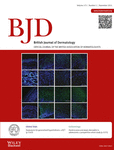

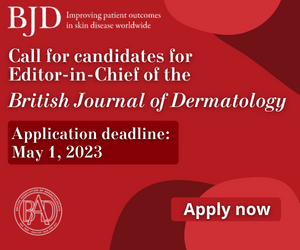
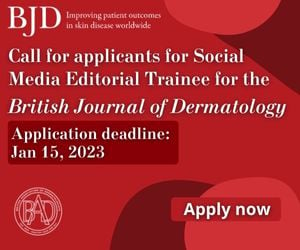

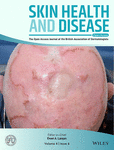
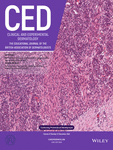
2690-442X.cover.png)